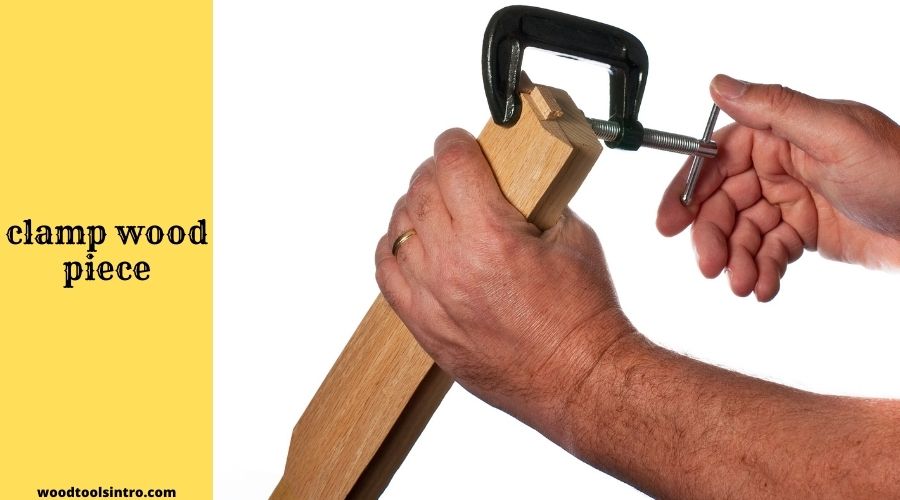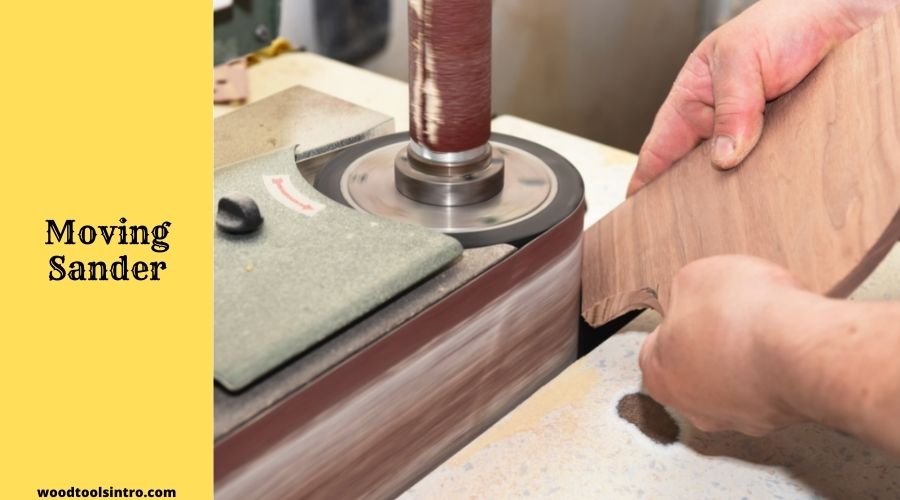When it comes to sanding wood pieces, belt sanders work the best for DIYers and hobbyists. The stationary belt sander is the kind of belt sander that you have to mount in a place to use it. It’s used for sanding smaller wood pieces. These sanders typically come with greater power than portable belt sanders.
Usually, stationary belt sanders have the same functionalities no matter which one you get. They differ in designs. Some have a horizontal orientation of the belt, while some will have a vertical. They also differ in sanding belt sizes, grit, sandpaper, weight, and size.
Now, if you don’t know how to use a stationary belt sander, I am here to help. I will take you through a step-by-step guide on using a stationary belt sander.
Let’s get this started.
Step By Step Using A Stationary Belt Sander
These are some easy-to-follow steps. You can follow these steps and get started with a stationary belt sander. Here’s what you do –

Clamping The Workpiece
For sanding with a stationary belt sander, you will need to clamp your wood piece first. You can’t start sanding without making the wood stable.

Also, make sure when you clamp the workpiece, it’s properly secured. Otherwise, you will end up with problems like slipping. The whole thing can even get a little dangerous.
You can use a workbench or a woodworking table if you have one. Then use the clamps to hold on to the workpiece while you sand using the stationary belt sander.
Protective Gears
While working with a belt sander, you have to wear protective gear, especially for your hands, eyes, and face. Sanding work involves a lot of dust and dirt that can damage your skin and hands.
Moreover, the speed at the sander works is surely dangerous for your hands and eyes.

You will need a goggle to protect your eyes. For the gloves, you can use regular work gloves. You will also need to use a respiratory protective system as sawdust will fly all over the place. So, you have to make sure it doesn’t cause any breathing issues.
Start The Motor
After you are done with the workpiece and have worn your protective gears, you can move on to starting the sander. You can start up the motor to power up the sander. It’s very easy to do since most stationary belt sanders come with a button.
Plug in your electric sander and start the motor. Make sure to keep the sander away from your body and your workpiece while doing that.
The Right grip
You will have to find the right grip for the sander and the workpiece. This is a very crucial part of getting that accuracy and method down to sanding.
Usually, a stationary belt sander has a rear handle where you have to grip the sander. This gives you control over the sander to move it around the workpiece unlike other small belt sander.

Now, the important thing here is that you get a grip that’s firm and comfortable. You don’t want discomfort while working with the sander. It can throw off your accuracy on the sander.
Also, the sander will move around a lot without a firm grip, which isn’t something you would want.
Moving The Sander
Here’s what makes a difference between good sanding and bad sanding. How you move the sander will give you the results you desire. You have to run the sander smoothly and don’t rush things. This way, you will end up with better results.

Also, while moving the sander, you have to keep the shape of the wood in mind. Especially when there are curves, you have to be extra careful. It isn’t easy to get smooth curves with your sander.
Sand It
All that’s left to do is sand. Keep the movements smooth while sanding and keep going back and forth. Remember to use the sander in a sideways motion as this gives your sanding the best appearance and results.
Also, make sure to do an even sanding. People often will sand one side more than the other, causing the workpiece to lose shape.
You have to hold the rear handle for stability and if there is a front handle, then use it for controlling the direction. And that’s it.
It’s not that difficult as it sounds to be. Just follow these steps properly. Once you get the hang of the movement, the whole thing will become much easier for you. All you have to do till then is practice a little bit.
What To Look For In Stationary Belt Sander
When you are trying to buy a stationary belt sander, you have to go through several factors. Considering these factors are important to get the best belt sanders suiting your needs.
Durability
You have to make sure that the build quality is pretty good on your belt sander. For that, try going for a belt sander that’s made of cast iron or maybe aluminum. These are great for sturdy construction, and they are quite stable to use.
Belt width
Having a wider belt width makes it easy for you to sand larger workpieces quickly. At the same time, you get to sand smaller pieces with it as well. So, it would help if you got a sander with a higher belt width.
Adjustability
You have to make sure there are adjustability options for your sander, such as adjustable mount height, belt frames, belt angles, and so forth. These allow you to work more freely in your workpiece.
Dust control
It’s important to have good dust control in your sander. Having this helps in making less mess while sanding wood. A good dust control system makes your work much cleaner and easier.
Stationary belt sander and drum sander differs in this feature.
Check out how to adjust belt sander
Stationary Belt Sander Safety Precaution
While using a belt sander, you have to maintain some safety measures. The tool can get a little dangerous to use if you are not careful. Here are the safety measures you should be aware of.
- You should use a dust collecting system while working with the sander
- Make sure to wear eye protection gears
- Whenever you are sanding, make sure to have a sanding motion away from your body.
- Before using your belt sander, you should check up on the belts first
- Always use both your hands to keep the sander stable and control it easily.
- Make sure to keep your hands away from the belt.
FAQ
Here are some common questions regarding a stationary belt sander.
If you are working with larger workpieces, the belt sander is a better option than the orbital sander. But for smaller workpieces, an orbital sander works better.
There are several things you should never do. Most importantly, never sand towards your body. Also, make sure you are keeping your hands away from the belt.
A belt sander is excellent for smoothening the surfaces of workpieces. It’s also great for scribing.
Wrap up
To sum it up, knowing how to use a stationary belt sander can be pretty handy. If you work with wood a lot and need a lot of sanding, you can get one for yourself.
This way, you don’t need to rely on professionals to get the sanding done. You can do it in your home. Most of all, it’s pretty easy to do as well.
Also Check Out Our Post on
- Wen handheld Belt Sander Review
- Best sandpaper for orbital
- Mouse or Orbital
- Disc or Belt Sander
- Cyber monday deal of table saw

I am Imtiaj Islam. I am a wood working enthusiast, having 6 years of experience in carpentry work. I have a BBA graduate degree from Chittagong College. I got vocational training on wood works from Korean Polytechnic out of the quest and zest he has for carpentry as well. I take several wood projects and keep testing different woodworking tools for comfortable and perfect work. I just love playing with woods and machines.
